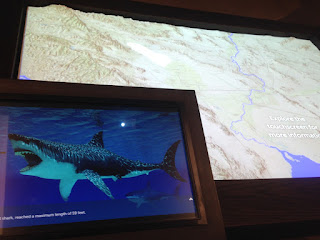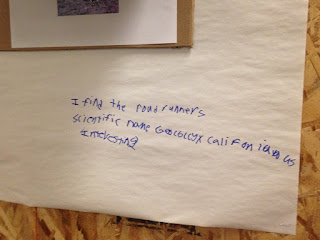 |
|
Education staff member
Angelina Coble talks about drought resistant plants in the Hector Sanchez Eagle Scout garden |
Our visitors want to learn about the desert. This has been
made clear over the last several months as we have been collecting information
from visitors and members in preparation for completing a new five-year
Strategic Plan. We have piloted
field trips hiking around our property. The one Eagle Scout garden that was
planted in 2014 is beginning to look amazing. We have just been asked to give a desert hiking experience
to a group of educators who don't really want to go that far into the desert.
Though we have not quite completed all phases of the interior exhibits, part of
the Museum’s long-term plan must now look at addressing questions and
opportunities outside of the museum as well.
Preserving the Desert
Last year, the Desert Museum and the Kumeyaay Diegueno Land Conservancy collaborated on a project to protect 15 acres of vacant desert land
near the museum. The Kumeyaay people have the most diverse traditional
landscape of any people in the Americas: going from the Pacific coast, through
the mountains, to the lakeshore, the desert, and into Baja California. The partnership between IVDM and KDLC
created a mechanism where desert land could be purchased, protected, and used
for museum and education programs.
 |
| New properties will be used for museum and education programs |
In July, the Desert Museum received a grant from the ProtectOur Communities Foundation to buy and protect two additional parcels of land
directly adjacent to the museum parking lot. The grant of $140,000 allowed the museum to acquire the
parcels, and working with the KDLC, conservation easements will ensure that
these properties will forever be used for museum and education programs.
For years the museum has been surrounded by vacant desert
land. The museum was built to be a low-impact building within this environment.
Driving past the museum on Interstate 8 the surrounding desert land is
striking, but it was never protected. Now it is.
Part of the Museum’s mission is to preserve desert lands.
Part of that mission is also to celebrate and educate people about the desert.
Visitor feedback has shown that people are unanimously interested in seeing the
museum expand its exhibits to the outdoors. Acquiring and preserving the properties around us will allow
us to develop programs for the public, interpret the importance of our drought
resistant desert plants, and allow access to the beauty of the desert
biome.
The Great Outdoors
 |
| 6th graders from Sunflower Elementary hike on museum lands in the 2015 school season |
Many people who come to the Desert Museum for the first time
come in thinking that the desert is boring. “There’s nothing there” is a common statement. Our interior exhibits are designed to
make people think about what they see when they are outside, and to understand
what they are seeing. The Rock Talk pullouts and the Land of Extremes panoramas
were created to give visitors a new view of the land. We hope that making connections like this will make more
people interested in going out on hikes and putting that knowledge into
practice. With the protection of the properties near the museum, we will now
have the ability to get people directly out into a desert environment. This is
a game changer.
Partners and Friends
We have been working on protecting all of the property
around the museum for more than a year. This could never have happened without
the help of our friends and partners.
Our partnership with the Kumeyaay Diegueno Land Conservancy
has been a huge success. The KDLC is an organization that has benefitted from
the support from nine of the twelve Kumeyaay Bands in the United States. They
are a nonprofit organization dedicated to preserving and protecting
environmentally and culturally sensitive lands within the traditional Kumeyaay
territory. The museum is hoping
that the partnership will be long-term and will result in some great projects.
Mary Anne Zimmerman, Attorney-at-law, was indispensable in
creating a draft conservation easement. She has been a long-time member and
supporter of the museum. At a critical time, she was able to provide council
and a direction that proved successful.
The grant process with the Protect Our Communities
Foundation began in October 2015. We appreciate their communication and
diligence at following through with our proposals. In the end, we achieved even
more than we had expected when we applied for their grant. Their aid in
protecting vacant desert land around the museum will benefit the education of
generations of students in Imperial County.



